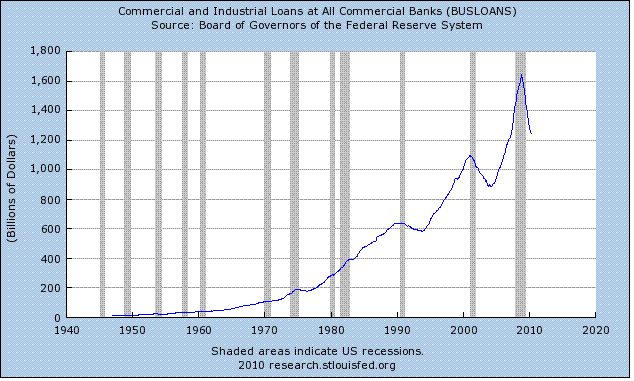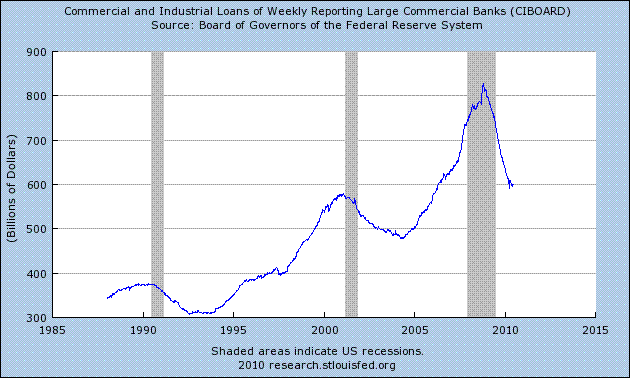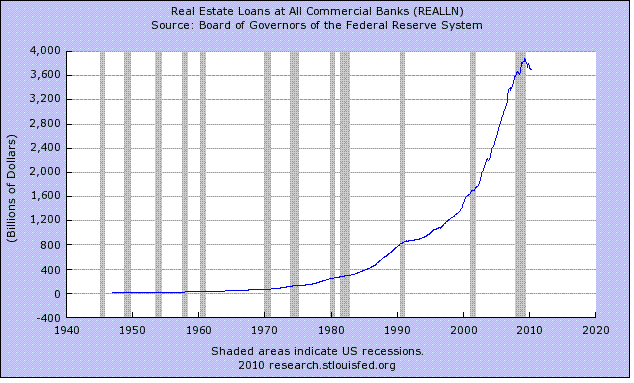U.S. Economic Recovery and Weak Loan Demand
Economics / Economic Recovery Jul 14, 2010 - 01:22 AM GMTBy: Hans_Wagner
 You have heard that loan growth is one of the critical elements of economic growth. The last recession saw total outstanding loans plummet as banks tightened up their credit standards and credit demand fell. So far, business loans remain weak indicating business of all sizes are not looking for more credit.
You have heard that loan growth is one of the critical elements of economic growth. The last recession saw total outstanding loans plummet as banks tightened up their credit standards and credit demand fell. So far, business loans remain weak indicating business of all sizes are not looking for more credit.
The Loan Picture
Following the adage that a picture is worth a thousand words, I have taken several charts from the St. Louis Federal Reserve FRED database. As shown below commercial and industrial loans outstanding have fallen almost 25% in the last few years. Recessions see loan demand fall, though the latest recession experienced the largest drop in recent memory.

The drop in loans outstanding follows a similar pattern for the large commercial and industrial banks indicating that many large companies are not looking for additional credit as either they have sufficient cash or they do not need more credit given their current business conditions. Again, the pattern is similar, though the fall off in outstanding loans was steep and has not turned up yet.

You might have heard that the consumer is cutting back in their spending and borrowing. Ignoring the spike that just took place, you can see that the consumer has not cut back on their borrowing all that much. Instead, the consumer is saving more while their level of borrowing remains relatively constant. Again, this ignores the aberration of the spike shown in the chart. It looks like the consumer is not cutting back on their borrowing all that much.

Ok, we all know that real estate loans were at the heart of the credit crisis. Yet the total outstanding real estate loans remain high even though there is a small pull back. Of course, real estate loans are long-term commitments, so any fall off will be significant. Yet the drop in outstanding real estate loans on a percentage basis is small.

This story in pictures tells us the economic slowdown is having an affect on everyone and has not recovered despite all the encouragement in various forms. The reduction in business loans is the most significant category that negatively affects economic growth.
So why is this taking place? Some attribute it to better lending standards. This is definitely true. Banks are doing a better job of screening their loan applicants. As a test, I recently tried to get a loan for my Trading Online Markets business. I did not need the loan, but I want to try to see what might be the outcome. I was refused a loan as my business had not be in place long enough (we have been in business five years and making money each month since we began). Second, we were too small with no prior credit history. Hard to build a credit history if no one will lend to you. Anyway, it was an eye opening experience. I empathize with other small business owners, who really need a loan to grow their business,
By the way, I do not need a loan, I was just trying to understand the loan and borrowing situation more closely.
Some equate the fall off in outstanding loans to lack of demand from borrowers. Companies are avoiding new borrowing as they try to fund their business on the cash they generate. Moreover, these companies are not experiencing sufficient growth in their business to justify new borrowing.
Implications for Investors
Sensible loan growth is essential for economic growth. Loan growth goes hand in hand with economic growth. Since business loan growth remains weak, it indicates the companies big and small remain concerned that that their prospects are worrisome. For investors, the weak loan growth tells us that the economy remains relatively weak. Companies that hold lots of cash can grow without having to depend on the credit markets. This means if you are analyzing a company, the ones with extra cash on their balance sheet gives them an added edge to grow their business. Cash remains king.
From a broader context, the U.S. economy will remain in a slow growth mode as long as loan growth is either negative or remains tepid. Therefore, occasionally monitor overall loan growth to see if and when it turns up as that will be a sign that economic growth is expanding. Until then the U.S. economy will remain in slow growth mode at best. We need to adjust our view of the markets accordingly.
By Hans Wagner
tradingonlinemarkets.com
My Name is Hans Wagner and as a long time investor, I was fortunate to retire at 55. I believe you can employ simple investment principles to find and evaluate companies before committing one's hard earned money. Recently, after my children and their friends graduated from college, I found my self helping them to learn about the stock market and investing in stocks. As a result I created a website that provides a growing set of information on many investing topics along with sample portfolios that consistently beat the market at http://www.tradingonlinemarkets.com/
Copyright © 2010 Hans Wagner
If you wish to learn more on evaluating the market cycles, I suggest you read:
Ahead of the Curve: A Commonsense Guide to Forecasting Business and Market Cycles by Joe Ellis is an excellent book on how to predict macro moves of the market.
Unexpected Returns: Understanding Secular Stock Market Cycles by Ed Easterling. One of the best, easy-to-read, study of stock market cycles of which I know.
The Disciplined Trader: Developing Winning Attitudes by Mark Douglas. Controlling ones attitudes and emotions are crucial if you are to be a successful trader.
© 2005-2022 http://www.MarketOracle.co.uk - The Market Oracle is a FREE Daily Financial Markets Analysis & Forecasting online publication.



